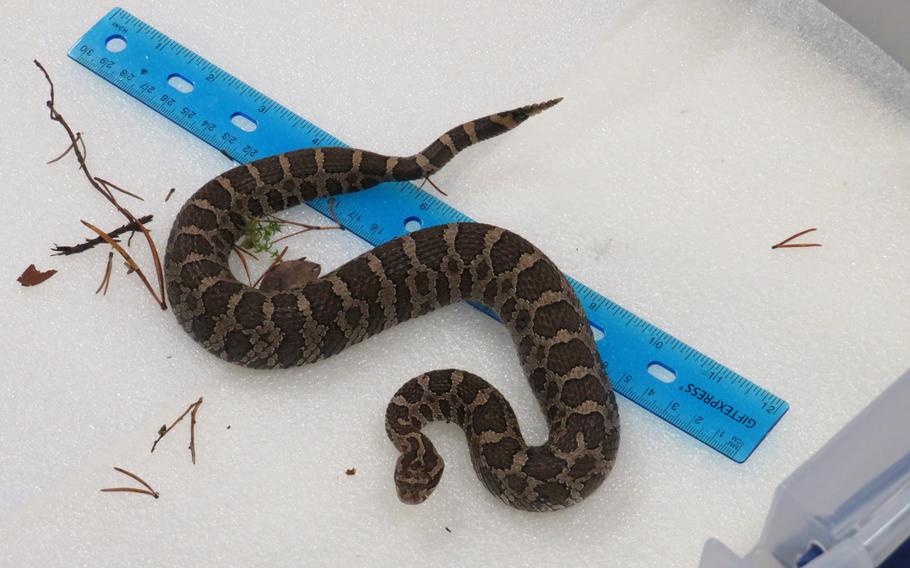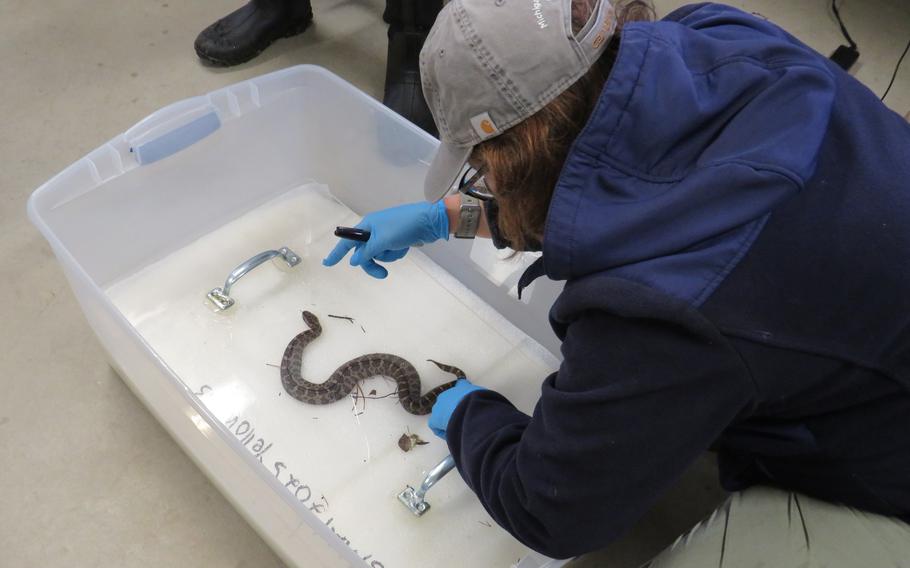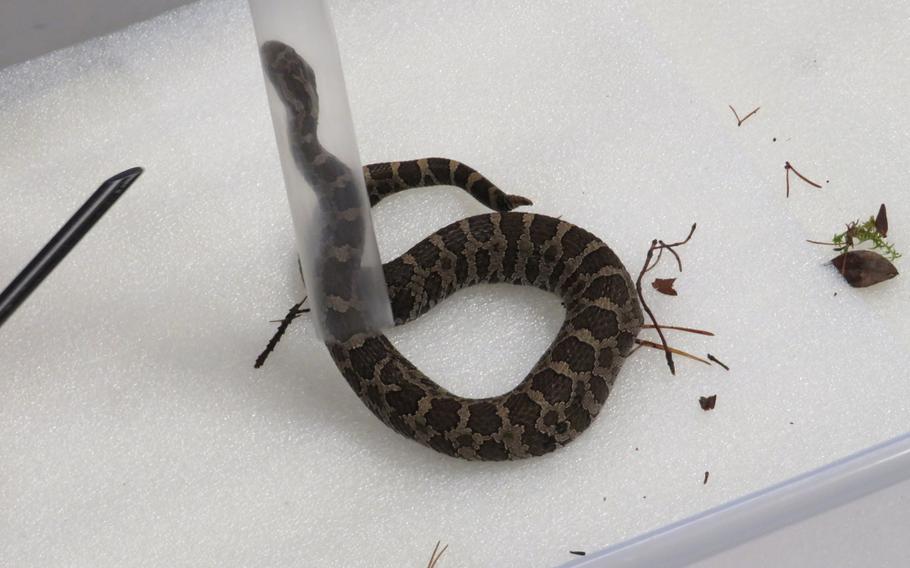
An adult male eastern massasauga rattlesnake was captured by volunteers at Camp Grayling on Tuesday, May 6, 2025. The snake was brought to a small field lab at the military base to be measured, tagged with a microchip, and checked for health problems. (Sheri McWhirter/MLive.com via TNS)
GRAYLING, Mich. (Tribune News Service) — It’s snake week at Camp Grayling.
Each spring, dozens of conservation researchers and volunteers descend on the Michigan Army National Guard base in northern Lower Michigan for four days of scientific rattlesnake wrangling. Venomous eastern massasauga rattlesnakes are captured in what’s called a “blitz style” field survey, then are carefully inspected by scientists and returned to the exact spot they were found in nature.
Camp Grayling’s resident rattlesnake population is part of multi-year research expected to help conservation scientists ultimately bolster the federally threatened species and recover its dwindling population in Michigan and elsewhere. This was the 7th year of data collection in the unique, long-term study of the species.
This year, survey teams captured 38 of the rattlesnakes, officials said.
Sometimes the searchers even find the same snakes again and again. They keep track with microchips injected beneath the skin, just like with pet dogs or cats.
“Yesterday, we had an adult female that was originally captured in 2018 as an adult,” said Matt Kleitch, Camp Grayling’s natural resource and environmental manager.
“And she was pregnant this year, too,” he said. “We could feel the embryos in there.”
That means the gravid, or pregnant, female was at least 10 years old and still reproducing as part of what Kleitch called a “robust” population of eastern massasaugas at the military base.
Despite the constant drizzle on the morning of Tuesday, May 6, field searchers captured three rattlesnakes at Camp Grayling before calling off the rest of the afternoon for poor weather. Officials said finding even that many on a cold, rainy spring day was impressive given the species’ renowned elusiveness.
“They don’t mess with people. They’re not interested in infringing on anybody. They just want to bask in the sun and eat rodents,” said Morgan Boyer, a zoological technician with Michigan Natural Features Inventory (MNFI) who assisted on a field team.
Although temperaments of individual snakes vary, the eastern massasauga rattlesnake is generally considered timid. Wildlife experts say it typically won’t strike or bite unless stepped on or otherwise touched, which only rarely happens.
“They’re a really cool snake, just the fact that they’re adapted to these northern climates, unlike most other rattlesnakes,” Boyer said.
And as a keystone species, the eastern massasauga is an indicator of high-quality wetland ecosystems. A decline in the venomous snakes means there’s something wrong happening with the habitat.
“The finger on the pulse is the eastern massasauga,” Boyer said.

Conservation scientist Yu Man Lee, of Michigan Natural Features Inventory, closely observes an adult male eastern massasauga rattlesnake held down beneath plexiglass on Tuesday, May 6, 2025, at Camp Grayling in northern Michigan. She describes each of the specific markings for the full length of the venomous snake while another scientist records the information. (Sheri McWhirter/MLive.com via TNS)
Michigan is considered the last stronghold of this rattlesnake species, with a greater population than any other U.S. state or Canadian province in its natural habitat range. Eastern massasaugas can be found in scattered locations in Illinois, Indiana, Iowa, New York, Ohio, Pennsylvania, Wisconsin and Ontario.
The primary reasons attributed to the snake’s decline is habitat loss or fragmentation, as well as indiscriminate killing by humans and illegal collection. Scientists are also studying the impact of climate change and wintertime snow depth loss on reproduction rates and overall survivability of the rattlesnake species.
Each time an eastern massasauga is spotted during snake week at Camp Grayling, a federally licensed field expert uses tools like a snake hook or grabber tongs to safely capture the creature and place it within a pillowcase inside a 5-gallon plastic bucket.
Back at a small field laboratory, other scientists receive each rattlesnake and carefully remove them from the bucket and pillowcase with the same types of tools. Then they collect a variety of data points for the ongoing herpetological research project.
On May 6, they processed an adult male rattlesnake that had never been captured before.
“They’re hard to find. There’s a good chance survey crews have walked by the snake multiple times before and just didn’t see it because they just kind of hunker down and they’re camouflaged,” Kleitch said.
The researchers weighed and measured the length of the male rattlesnake before they injected a tiny microchip beneath its skin.
First, MNFI conservation scientist Yu Man Lee worked with wildlife biologist Mike Ravesi to manipulate the “business end” of the rattlesnake into a plastic tube. That allowed them to safely handle the venomous snake without being bitten.
They recorded detailed descriptions of the snake’s saddle — the term for the pattern or markings that run the length of a snake’s body. They also counted tail rattle segments and inspected for any signs of snake fungal disease.
“Each one of the separate segments is called a button,” Ravesi said. “This one ... the very end of the last button is intact, but every time they shed, they’ll add another button segment.”
However, it’s not true that you can tell the age of an eastern massasauga rattlesnake by the number of buttons in the rattle. That’s because they break off naturally over time, Ravesi said.
Kleitch said knowledge learned from the Camp Grayling population of the venomous snakes is expected to provide critical information for the species’ recovery plan. Eastern massasaugas were listed as federally threatened in 2016 and the long-term study will help answer questions about the greater health and viability of the species, he said.
“We try to time the survey within a couple weeks of emergence. So, when these snakes are coming out of hibernation, out of their overwintering areas, we’re trying to capture that window,” Kleitch said.

The head of an eastern massasauga rattlesnake is placed inside a plastic tube so wildlife scientists can safely handle the federally threatened species on Tuesday, May 6, 2025, at Camp Grayling in northern Michigan. (Sheri McWhirter/MLive.com via TNS)
©2025 Advance Local Media LLC.
Visit mlive.com.
Distributed by Tribune Content Agency, LLC.